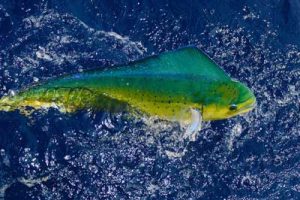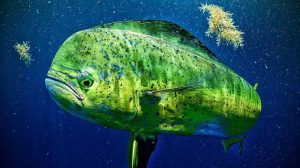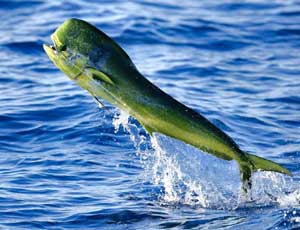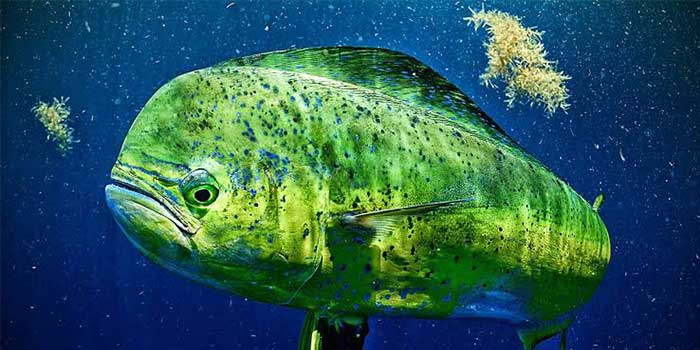“THE RABBIT OF OCEAN – DOLPHIN FISH”

A dolphin fish, also known as mahi-mahi, is a constant in tropical waters, While the dolphin fish is not actually a dolphin, it is a large, strong, fish that has a dorsal fin, which may inspire some comparisons to dolphins. The dolphin fish, like dolphins, are predators, and mainly roam the seas in the Gulf of Mexico, the Caribbean, and Hawaii. The dolphin fish is a brightly colored, vibrant fish that is an important part of ocean ecosystems. There are actually two species of dolphin fish the common dolphin fish, scientific name Coryphaena hippurus, and the pompano dolphin fish, Coryphaena equiselis. The two species are very similar, but the pompano dolphin fish is a bit smaller. Both are referred to as mahi-mahi.
Physical characteristics:
- Dolphin fish are a large species of fish that have a single dorsal fin that extends from the head to the tail.
- Males’ heads are rounded to the point where they protrude out.
- Females’ heads are rounded and smooth.
- The dolphin fish is also a vibrant, brightly colored fish that is golden on the sides.
- Brightly colored blue and green on its sides and back.
- Mahi mahi fish grow to be 2.5-4.5 feet long, and catches have been recorded from 15 pounds to over 40 pounds.
 Habitat:
Habitat:
Dolphin fish are found in the Indian, Pacific, and Atlantic Oceans in tropical and subtropical waters. They dwell in temperatures that are at least 90 degrees, usually on or near the equator. While mahi mahi fish are most common in and prefer tropical waters, they can also be found in cooler waters as far north as Massachusetts. Dolphin fish stay near the surface of the water, and close to the shore. They can usually be found in depths up to 250 feet. Dolphin fish are especially prominent in the Caribbean and the Gulf of Mexico, where a majority of fishing takes place. The dolphin fish is also found in large numbers off the coast of Hawaii.
Life Cycle:
Dolphin fish reproduce at a rapid rate. They are sometimes jokingly referred to as “the rabbits of the ocean” Dolphin fish reach maturity at 4-5 months old, and should definitely be fully mature by the time they’re a year old.
Female dolphin fish can lay 100,000-1,000,000 eggs at a time and can lay eggs 2-3 times per year. Dolphin fish don’t have strict migratory patterns. They usually swim north as waters warm, and populations in those northern areas peak around July.
The fish can live up to five years, but it’s rare for them to exceed four, and the average lifespan is estimated to be 2-3 years. They’re usually caught by fishermen or predators.

Fishing & Conservation:
The dolphin fish is sometimes called “a gift for fisherman” because they are near the coast, close to the surface, and the fish usually yields a lot of meat.
The mahi mahi fish is not considered endangered, and is cited as an environmentally-friendly fish for consumption. Due to their rapid reproduction rate, the dolphin fish replaces its population quickly,
Though the dolphin fish is not in immediate danger of extinction or significant population decrease, like all ocean dwelling creatures, issues associated with climate change could impact the fish.
How Is a Dolphin Fish Different from a Dolphin?
- Despite the name, dolphin fish and dolphins have virtually nothing in common, other than that they both swim. Is a dolphin a fish? No! The dolphin is a mammal, which is warm blooded, and has live births.
- The dolphin fish is a fish. Both animals do have a dorsal fin; the dolphin fish’s dorsal fin runs along most of its body, while the dolphin’s dorsal fin is in the center of its back.
- It’s likely that the misnomer for the dolphin fish came from the old scientific naming and classification system. Previously, the dolphin fish was categorized in the “Dolfyn” family, instead of the Coryphaena family. The bottlenose dolphin is in the family Delphinidae.
- As you can see, the dolphin fish and dolphin are not in the same scientific family, or genus, which demonstrates their lack of relationship with one another.
Dolphin Fish Fun Facts:
- The dolphin fish is a very fast swimmer, reaching speeds of up to 60 mph.
- The name “mahi-mahi” literally means “strong strong” in Polynesian. The name originates from Hawaii, where the fish are prevalent
- The fish is also called “dorado” in Spanish, a name that stems from its golden color.
- Dolphin fish lose their golden hues once they leave the water, and eventually turn a silvery color.
- Dolphin fish eat crab, squid and other crustaceans, as well as on other fish, like mackerel.
- Outside of the Caribbean, the United States is the largest consumer of dolphin fish
- Dolphin fish do not raise their young. Once the eggs hatch, the young dolphinfish quickly band together in schools to help ensure survival.
- The young fish, and smaller dolphin fish, travel in schools of anywhere from a handful of fish to up to fifty fish. Larger fish travel alone, or sometimes in pairs.
- The main predators of dolphin fish are sharks, swordfish, marlins, birds, and of course, humans.
- Dolphin fish are very strong, and are known for being difficult to catch on fishing lines.
- The largest dolphin fish ever recorded was found on September 25th, 1976, weighing about 87 pounds.
Keywords: Dolphin, Mahi Mahi, dolphin fish, Ocean, Tropical water, Migratory, fishing, Swimmer.
Written by

– CH. ARAVIND KUMAR –

